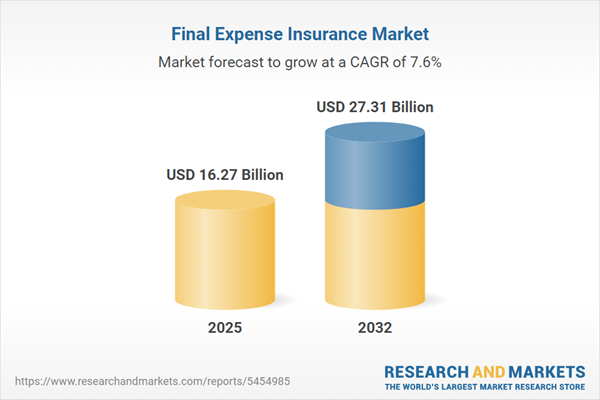Speak directly to the analyst to clarify any post sales queries you may have.
The final expense insurance market is rapidly adapting to major demographic, regulatory, and technological shifts, requiring executives to rethink distribution, product design, and strategic partnerships. This report provides senior decision-makers actionable insights for achieving resilience and competitive advantage in a changing insurance sector.
Market Snapshot: Final Expense Insurance Market Size and Growth
The Final Expense Insurance market grew from USD 15.19 billion in 2024 to USD 16.27 billion in 2025, and is projected to reach USD 27.31 billion by 2032 at a CAGR of 7.60% during the forecast period.
Scope & Segmentation
- Product Types: Guaranteed Issue, Simplified Issue, Term Life Insurance, Whole Life Insurance
- Age Groups: Under 50, 50 to 59, 60 to 69, 70 and above
- Gender: Female, Male
- Premium Types: Flexible Premium, Lump Sum Payment, Monthly Premium
- Coverage Amounts: Below $10,000, $10,000–$20,000, Above $20,000
- Distribution Channels: Affinity Groups (Professional Associations, Senior Associations/Clubs), Banks, Brokers, Direct to Consumer
- Target Customers: Individuals (including those with pre-existing conditions, low-income), Businesses for Employee Plans (Government Employees, Private Enterprises, Unionized Workplaces)
- Regions Covered: Americas (North America: US, Canada, Mexico; Latin America: Brazil, Argentina, Chile, Colombia, Peru), Europe, Middle East & Africa (Europe: UK, Germany, France, Russia, Italy, Spain, Netherlands, Sweden, Poland, Switzerland; Middle East: UAE, Saudi Arabia, Qatar, Turkey, Israel; Africa: South Africa, Nigeria, Egypt, Kenya), Asia-Pacific (China, India, Japan, Australia, South Korea, Indonesia, Thailand, Malaysia, Singapore, Taiwan)
- Companies Analyzed: AAA Life Insurance Company, Aflac Incorporated, Allianz SE, Anthem Insurance Group Inc., Assurity Benefits Group, Bajaj Finserv Limited, Corebridge Financial Inc., CVS Final Expense by Accendo Insurance Company, Fidelity Life Association, First Generation Life, Gerber Life Insurance Company, Globe Life Inc., Londen Insurance Group Inc., Manulife Financial Corporation, MetLife Services and Solutions LLC, Mutual of Omaha Insurance Company, New York Life Insurance Company, Royal Neighbors of America, State Farm Mutual Automobile Insurance Company, Symmetry Financial Group by Quility Insurance Holdings, The Baltimore Life Insurance Company, The Savings Bank Mutual Life Insurance Company, Transamerica Corporation, TruStage Financial Group Inc., United Home Life Insurance Company
Key Takeaways for Senior Decision-Makers
- Growth in the final expense insurance landscape is closely tied to global demographic changes, especially increased life expectancy and evolving end-of-life planning preferences.
- Insurers are leveraging digital transformation to streamline underwriting, improve customer engagement, and accelerate policy issuance through cloud-based and modular platforms.
- Distribution strategies are shifting toward omnichannel engagement, including digital, affinity partnerships, and direct-to-consumer models to address fragmented consumer journeys.
- Product customization, flexible premiums, and innovative reinsurance arrangements are expanding access for underserved segments, including low-income policyholders and individuals with pre-existing conditions.
- Regional differences in compliance, consumer awareness, and adoption of technology require tailored solutions to address specific market dynamics in the Americas, EMEA, and Asia-Pacific regions.
- Strategic alliances between legacy insurers and fintech or insurtech startups are enabling rapid innovation and more differentiated offerings for diverse customer groups.
Tariff Impact: Navigating US Tariff Changes
The introduction of US tariff measures in 2025 has raised costs for carriers dependent on imported IT infrastructure and digital platforms. Insurers are responding by localizing technology stacks, diversifying suppliers, and seeking advances in open-architecture and cloud-native solutions to protect margins and build operational resilience.
Final Expense Insurance Market: Methodology & Data Sources
Research combines qualitative interviews with senior executives and industry partners, quantitative surveys targeting policyholders and intermediaries, and advanced analytics for robust segmentation. Data triangulation and validation ensure accuracy, with rigorous attention to regulatory and ethical standards throughout each phase of the study.
Why This Report Matters for Leadership Teams
- Enables identification of strategic product and distribution priorities that align with evolving consumer needs and regulatory requirements.
- Equips senior management with insights to optimize technology investments, partnership models, and customer engagement strategies across global regions.
- Supports scenario planning for tariff impacts, compliance shifts, and agile portfolio development to sustain growth and operational excellence.
Conclusion
The report delivers essential insights for decision-makers seeking to strengthen final expense insurance portfolios. By applying the findings, executives can foster innovation, optimize operational efficiency, and elevate customer and stakeholder outcomes in an advancing market environment.
Additional Product Information:
- Purchase of this report includes 1 year online access with quarterly updates.
- This report can be updated on request. Please contact our Customer Experience team using the Ask a Question widget on our website.
Table of Contents
3. Executive Summary
4. Market Overview
7. Cumulative Impact of Artificial Intelligence 2025
Companies Mentioned
The companies profiled in this Final Expense Insurance market report include:- AAA Life Insurance Company
- Aflac Incorporated
- Allianz SE
- Anthem Insurance Group, Inc.
- Assurity Benefits Group
- Bajaj Finserv Limited
- Corebridge Financial, Inc.
- CVS Final Expense by Accendo Insurance Company
- Fidelity Life Association
- First Generation Life
- Gerber Life Insurance Company
- Globe Life Inc.
- Londen Insurance Group, Inc.
- Manulife Financial Corporation
- MetLife Services and Solutions, LLC
- Mutual of Omaha Insurance Company
- New York Life Insurance Company
- Royal Neighbors of America
- State Farm Mutual Automobile Insurance Company
- Symmetry Financial Group by Quility Insurance Holdings
- The Baltimore Life Insurance Company
- The Savings Bank Mutual Life Insurance Company
- Transamerica Corporation
- TruStage Financial Group, Inc.
- United Home Life Insurance Company
Table Information
| Report Attribute | Details |
|---|---|
| No. of Pages | 193 |
| Published | November 2025 |
| Forecast Period | 2025 - 2032 |
| Estimated Market Value ( USD | $ 16.27 Billion |
| Forecasted Market Value ( USD | $ 27.31 Billion |
| Compound Annual Growth Rate | 7.6% |
| Regions Covered | Global |
| No. of Companies Mentioned | 26 |









